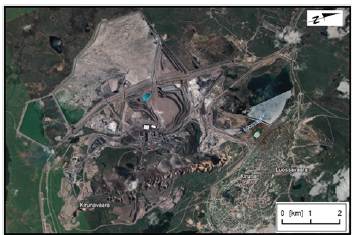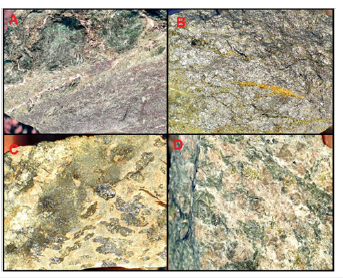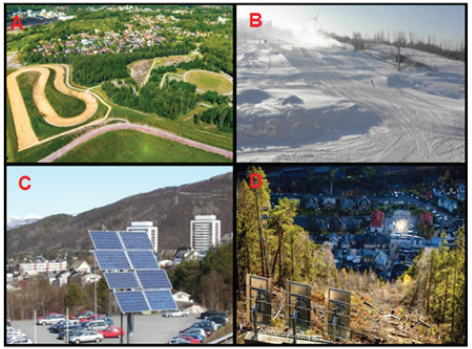- Submissions

Full Text
Aspects in Mining & Mineral Science
Sustainable Development Opportunities for the Kiruna Area (N Sweden)
Miłosz Huber*
Geology, Soil Sciences, and Geoinformacy Department, Earth and Environment Sciences Institute, Maria Curie-Skłodowska University in Lublin, Poland
*Corresponding author: Miłosz Huber, Geology, Soil Sciences, and Geoinformacy Department, Earth and Environment Sciences Institute, Maria Curie- Skłodowska University in Lublin, 2d/107 Kraśnickie Rd, 20-715 Lublin, Poland
Submission: October 13, 2022;Published: January 10, 2023

ISSN 2578-0255Volume10 Issue4
Abstract
The town of Kiruna in northern Sweden beyond the Arctic Circle is home to an iron ore mine that has been in operation since the late 19th century and is planned for about a century more. The mine heavily affects the urban landscape as its dumps and other infrastructure heavily distort it. The scenario proposed by the author allows for several solutions that fit into sustainable development, allowing the mining plant to continue operating while modifying the city’s landscape and restoring the utility of degraded areas. The proposed scenarios involve the re-exploitation of rock resources from dumps, the construction of renewable energy facilities, reforestation, and the location of tourist infrastructure.
Keywords:Sustainability; Dump recultivation; Renewable energy; Re-exploitation
Introduction
Figure 1:View of Kiruna and its surroundings: in the foreground is a dump and, in the distance, a broken hill in which there is a disused quarry.

Figure 2:Satellite image showing the city of Kiruna and the mining plant dumps dominating the city.

The Kiruna area is located in northern Sweden, in the Arctic Circle region. It is a complex of mines, a quarry (now closed), and dumps and other facilities that are used for ore extraction purposes. They are located practically in the center of the city. Kiruna is a town that owes its development to the mine. Due to the nature of the deposit, the mine will expand, gradually taking up urban space. There are plans to move the entire town to the northeast of the mine. Regardless of these plans, mining views dominate the city (Figures 1 & 2). dumps tens of meters high, mine shaft towers, and a “broken” mountain peak” are the work of the mining company. This article presents a draft proposal for changes that can improve the city’s landscape without closing the mine. This idea is important because in recent times there has been an increase in tourism due to the Arctic location of this city.
Methods
The present study was created as a result of the 2022 field reconnaissance and subsequent sampling of the dumps. The rock samples were transported to the Department of Geology, Soil Science and Geoinformation at the Institute of Earth and Environmental Sciences, where thin plate preparations were made, and then the rocks were examined using a Leica DM2500P polarizing optical microscope and a Hitachi SU6600 scanning electron microscope with an EDS attachment. Proposals for the reclamation of the site in question were then developed based on our observations and data from the literature. The results of these studies are presented below.
Results
Figure 3:Geological map of the Kiruna area (A, after [7], simplified by the author), historical and planned exploitation of the deposit (B, after [12,13], modified by the author).

The mine site currently covers an area of about 30 square kilometers near the city center. There are plans to expand the mine workings area in the near future. Quarries are also being opened in neighboring towns. The area represents proven and prospective metal deposits that are planned to be mined for many more decades (Figures 2 & 3).
Geology of the Kiruna area
The Kiruna area is located in the region of the northwestern part of the Baltic shield [1-5]. The bedrock consists of archaic rocks dated to the age of 2.7Ga, with a magmatic-sedimentary sequence metamorphosed in the greenstone facies [6,7]. Among these rocks is the Kiirunavaara Formation composed of trachyandesite porphyritic formations along with rhyodacitic pyroclastics, covered by a mixture of volcanic rocks (basalts, rhyolites) and sedimentary rocks (greywackes, Figure 3). On top of this formation are the Hauki quartzites [8-11]. Their age is about 1.9Ga. The deposit formation overlies the discussed rocks in the form of a magnetite body. The total size of the deposit is estimated at 2Gt. Next to it is the smaller Loussavaara deposit and the hematite- and phosphate-rich Per Gijer deposit belonging to the Matojärvi formation [12,13].
Status of mine site development
Figure 4:Examples of the rocks, present in the Kiruna dumps: greenstone (A), massive magnetite ore (B), magnetite porphyrite (C), and porphyrite (D).

The mine site has numerous spoil piles built from multiple levels surrounding the city to the west. Next to them are the tailings ponds and the Loussavaara Hill which is currently off-limits to mining. These areas tower over the city’s landscape, causing an overwhelming view of a heavily transformed landscape. The dump consists mainly of rocks such as secondarily transformed porphyrites, as well as greenstone crumbs and iron ores found. These ores occur both in massive form and as impregnations in the porphyrites (Figure 4).
Propositions of the dump’s recultivation
An important factor affecting the quality of life of residents is the landscape, which is currently dominated by dumps and the infrastructure of mining sites. To usher in changes to the city’s landscape, the following several action scenarios, known from various mining sites, grouped thematically, are proposed. An important action may be to undertake the leveling of the dumps in question by reusing the material found there. The dump-building porphyrites are rocks that can be used as ballast for building roads, bridges, and other field fortifications. Re-exploitation of the rock resources found in the dumps in question can be a source of additional income for the city and the mines and will also contribute to the leveling of the dumps in question and can counteract the construction of quarries to extract rock ballast elsewhere in Sweden [14,15]. The towering dump hills above the city can also be used as sites for renewable energy. Windmills and photovoltaic cells can be placed directly in the dumps [16]. Another solution can be the use of energy storage mechanisms, which can be placed in old pits and then used to give energy back, especially during the winter. Interesting use of the dump could also be to cover it with mirrors directing light to the city, this could have a significant impact on microclimate conditions, especially in the autumn and spring [17]. This is particularly important since Kiruna is located beyond the Arctic Circle in the Arctic part of Sweden and additional lighting by focusing the sun’s rays can positively affect residents. Alternatively, lighting could be used to illuminate crops for residents’ use or to store heat and convert it into energy storage for times when the city is perceived to have an inflated need for it. An example would be a heat storage tank based on hydrated sodium acetate or sodium thiosulfate, which could be heated on sunny days and return heat through crystallization energy on cold days [18].
Reforestation of dump leach pads is another proposal to enable changes in the urban landscape. Existing dumps in the vicinity of the city can be profiled to obscure other mining areas while shielding the city from the wind. Trees can be planted on the stable slopes of the dumps on the city’s side, to affect Kiruna’s landscape (Figure 5). Forestation of the dump will change their appearance, especially in spring and summer. Forested areas can absorb dust and pollution [19-22]. A further step could be to expand the sports infrastructure that exists in the city on former mining sites [23]. During the author’s stay in the summer of 2022, it was noted that the disused old roads surrounding the dumps serve as jogging paths for residents. Small improvements to these roads by building infrastructure to allow for outdoor exercise, and relaxation, or to enable cycling and winter skiing could begin to affect the wellbeing of residents [24-27]. In addition, they will make it possible to expand the tourist offer of Kiruna, which is located near the Abisko National Park [28-31].
Figure 5:Examples of dump recultivation: Park on dump site in Jaworzno (A, after [25,26]), Ski slope Mount Kamiensk in Belchatow (B, after [27], Photovoltaic panels in Narvik (C, after [16], Illuminating mirrors city of Rjukan in Norway (D, after [17]).

Discussion
The use of dumps for the reuse of the material in them is partially feasible. Not all of the surface of the dumps can be used because the Kiruna mining plant is active and will need a waste location, in addition, some of the dumps are unstable due to ground subsidence above the mine galleries. The admixtures of iron oxides that occur are not as threatening to the environment as non-ferrous metal ores and other substances. Hence, the use of the discussed rocks should not be environmentally burdensome [14,32-34]. The use of the discussed dumps as a source of renewable energy and its storage can be very important from the point of view of energy independence and diversification of energy sources [35]. Moreover, this fits into the currently outlined trend of enriching the share of energy from renewable sources for Europe. The use of solar panels in the Arctic is now widespread, examples being homes in Greenland or such cells observed by the author in northern Finland and Norway. Kiruna is further south of these places, so there these cells will have greater efficiency, while the use of wind turbines will be an even more powerful source of energy, as winds in the region in question are common and do not stop even in winter. Energy storage is also an important element, which can be obtained by preserving elevators in used mine galleries, which will be able to have new uses. In the march of increasing interest in renewable techniques, the number of ideas and innovations in this field is growing, so it can be assumed that there may be many more of these possibilities, adapted to Kiruna’s climate. The use of dump afforestation and the organization of active recreation paths can be one of the most important priority actions, as residents are already interested in this type of activity, and in the future, it will allow expanding the range of active forms of recreation for tourists as well. It is also worth mentioning that the existing ski slope in the Loussavaara area needs to be modernized and could also be adapted to year-round offers, laying, for example, igneous. In conclusion, it should be said that while the mining plant will be active, its full reclamation will not be possible, but it can be applied partially, to reduce the impact on nature and the landscape of the city of the existence of this plant. The above-mentioned scenarios are also applicable as a hybrid of all the ideas given above. The degree of implementation of each of them can be based on public consultation and the specifics of the region.
Conclusion
The site in question is located with a large iron ore deposit, which, due to its multiplicity, is scheduled for further mining for many decades to come. However, given the overwhelming size of the mining site in the city in which it is located, it is worth considering the scenario of partial reclamation of this area, which is not directly exploited. This will have a positive impact on the city’s landscape and the well-being of its residents. The proposed scenarios involve the re-exploitation of dumps using their rock material. Building facilities on their surface and inside them for renewable energy generation and storage can be a practical and necessary solution. Reforesting them will have a positive impact on the city’s landscape and installing tourist infrastructure will expand the range of services for residents and visitors.
References
- Baluev AS, Zhuravlev VA, Przhiyalgovskii (2009) ES new data on the structure of the central part of the white sea paleorift system. Doklady Earth Sciences 427: 891-896.
- Bayanova T, Korchagin A, Mitrofanov A, Serov P, Ekimova N, et al. (2019) Long-lived mantle plume and polyphase evolution of palaeoproterozoic PGE intrusions in the fennoscandian shield. Minerals 9(59): 3-22.
- Bayanova TB, Kunakkuzin EL, Serov PA, Fedotov DA, Borisenko ES, et al. (2018) Precise U-Pb (Id-Tims) and SHRIMP-II ages on single zircon and Nd-Sr signatures from Achaean TTG and high aluminum gneiss on the Fennoscandian Shield. 32nd Nordic Geological Winter Meeting, Helsinki, Finland pp. 13-15.
- Bayanova TB, Ludden J, Mitrofanov FP (2009) Timing and duration of Palaeoproterozoic events producing ore-bearing layered intrusions of the Baltic Shield: metallogenic, petrological and geodynamic implications. In: Reddy SM, Mazumder R, Evans DAD, Collins AS, (Eds.), Palaeoproterozoic Supercontinents and Global Evolution 323: 165-198.
- Ernst R, Bleeker W (2010) Large igneous provinces (LIPs), giant dyke swarms, and mantle plumes, significance for breakup events within Canada and adjacent regions from 2.5Ga to the Present. Canadian Journal of Earth Sciences 47(5): 695-739.
- Martinsson O (2004) Geology and metallogeny of the Northern Norrbotten Fe-Cu-Au province. In: Allen RL, Martinsson O, Weihed P (Eds.), Svecofennian Ore-Forming Environments: Volcanic-associated Zn-Cu-Au-Ag, intrusion-associated Cu-Au, sediment-hosted Pb-Zn, and magnetite apatite deposits in Northern Sweden Soc Econ Geol, 33: 131-148.
- Martinsson O, Nordstrand J, Rutanen H, Scott A (2013) In: Martinsson O, Wanhainen C (Eds.), Fe oxide and Cu-Au deposits in the NOrthern Norrbotten ore district. Geol Surv Sweden, pp. 44-53.
- Bozhko NA (2010) Intraplate basic–ultrabasic magmatism through time in terms of supercontinental cyclicity. Moscow University Geology Bulletin 65(3): 161-176.
- Bozhko NA (2011) On two types of supercontinental cyclicity. Moscow University Geology Bulletin 66(5): 313-322.
- Bozhko NA (2009) Supercontinental cyclicity in the earth’s evolution. Moscow University Geology Bulletin 64(2): 75-91.
- Glebovitsky VA (2005) Early precambrian of the baltic shield. Nauka St Petersburg, Russia, p. 710.
- Jonsson E, Troll VR, Hogdah K, Harris C, Weis F, et al. (2013) Magmatic origin of giant ‘Kiruna-type’ apatite-iron-oxide ores in Central Sweden. Nature Scientific Reports 3: 1644.
- Ptak M, Podolska M, Podolski R (2018) Challenges for science: the exploitation of deep deposits. XVIII Conference of PhD Students and Young Scientists E3S Web of Conferences 71: 00008.
- Troll VR, Weis FA, Jonsson E, Andersson UB, Majidi SA, et al. (2019) Global Fe-O isotope correlation reveals the magmatic origin of Kiruna-type apatite-iron-oxide ores. Nature Communications 10: 1712.
- Ignatyeva M, Yurak V, Pustokhina N (2020) Recultivation of post-mining disturbed land: Review of content and comparative law and feasibility study. Resources 9: 73.
- Jończy I, Huber M, Lata L (2014) Vitrified metallurgical wastes after zinc and lead production from the dump in Ruda Śląska in the aspect of mineralogical and chemical studies. Mineral Resources Management 30(1): 161-174.
- Kleven ØH, Persson H, Good C, Sulkowski W, Boström T (2009) Solar cells above the arctic circle–A comparison between a two-axis tracking system and simulations.
- (2015) Rjukan - a dark town illuminated by mirrors. Poland.
- Huber M, Rusek A, Menshakova M, Zhigunova G, Chmiel S, et al. (2022) Possibilities of sustainable development including improvement in air quality for the city of murmansk-examples of best practice from Scandinavia, Climate 10(2): 15.
- Aamlid D, Venn K (1993) Methods of monitoring the effects of air pollution on forest and vegetation of eastern Finnmark, Norway. Norw J Agr Sci 7: 71-87.
- Aune S, Hofgaard A, Söderström L (2011) Contrasting climate-and land-use-driven tree encroachment patterns of subarctic tundra in northern Norway and the Kola Peninsula. Can J For Res 41(3): 437-449.
- Huber M, Iakovleva O (2021) Tourism, scientific, and didactic potential of the ultrabasic-alkaline intrusion in afrikanda with perovskite mineral (Kola Peninsula, N Russia) and of the related built heritage. Heritage 4: 3892-3907.
- Huber M, Zhigunova G, Menshakova M, Iakovleva O, Karimova M (2021) Geoheritage of the Monchegorsk Igneous layered paleoproterozoic intrusion (Kola Peninsula, Arctic Russia): Evaluation and geotourism opportunities. Heritage 4: 3583-3610.
- Gürer A, Gürer ÖF, Sangu E (2019) Compound geotourism and mine tourism potentiality of Soma region, Turkey. Arabian Journal of Geosciences 12: 734.
- Pactwa K, Woźniak J, Dudek M (2020) Coal mining waste in Poland in reference to circular economy principles. Fuel 270: 117493.
- (2020) ‘English Park’ -area of the former Pilsudski dump. Jaworzno Government materials.
- (2022) Dump replacement in Park.
- (2022) Kamiensk Mountain -Slope in the center of Poland.
- Johansson P, Lauri LS, Voytekhovsky YL (2014) Barents tour for geotourists. Kolarctic, Rovaniemi Finland Publishing House, Finland.
- Gravis I, Németh K, Twemlow C, Németh B (2020) The case for community-led geoheritage and geoconservation ventures in māngere, South Auckland, and Central Otago, New Zealand. Geoheritage 12: 19.
- Hose TA (2012) 3G’s for modern geotourism. Geoheritage 4: 7-24.
- (2022) Kiruna Visitor center.
- Knapp S, Klotz S, Gerth A (2012) Sustainable recultivation and wastewater treatment in Vietnamese coal mining. World of Mining - Surface and Underground 64: 253-261.
- Woodard C (2005) Industrial waste treatment handbook. (2nd edn), Butterworth-Heinemann, UK, p. 480.
- Dhal B, Das NN, Thatoi HN, Pandey BD (2013) Characterizing toxic Cr(VI) contamination in chromite mine overburden dump and its bacterial remediation. Journal of Hazardous Materials 260: 141-149.
© 2023 Miłosz Huber. This is an open access article distributed under the terms of the Creative Commons Attribution License , which permits unrestricted use, distribution, and build upon your work non-commercially.
 a Creative Commons Attribution 4.0 International License. Based on a work at www.crimsonpublishers.com.
Best viewed in
a Creative Commons Attribution 4.0 International License. Based on a work at www.crimsonpublishers.com.
Best viewed in 







.jpg)






























 Editorial Board Registrations
Editorial Board Registrations Submit your Article
Submit your Article Refer a Friend
Refer a Friend Advertise With Us
Advertise With Us
.jpg)






.jpg)














.bmp)
.jpg)
.png)
.jpg)










.jpg)






.png)

.png)



.png)






